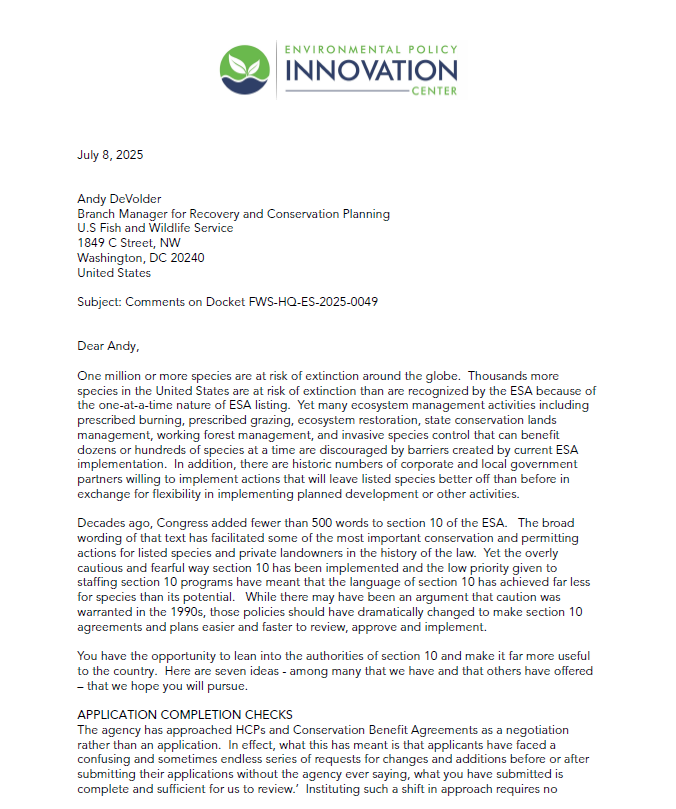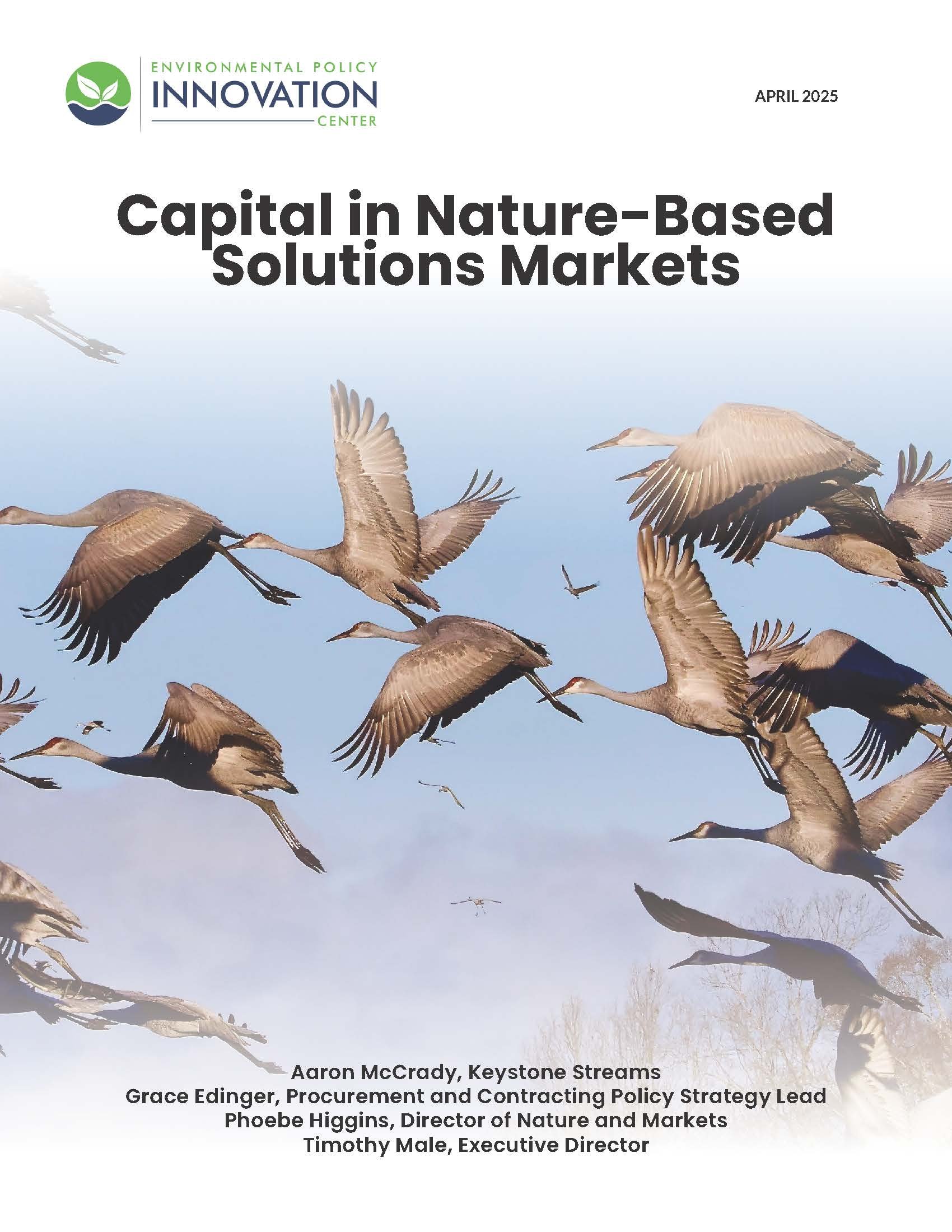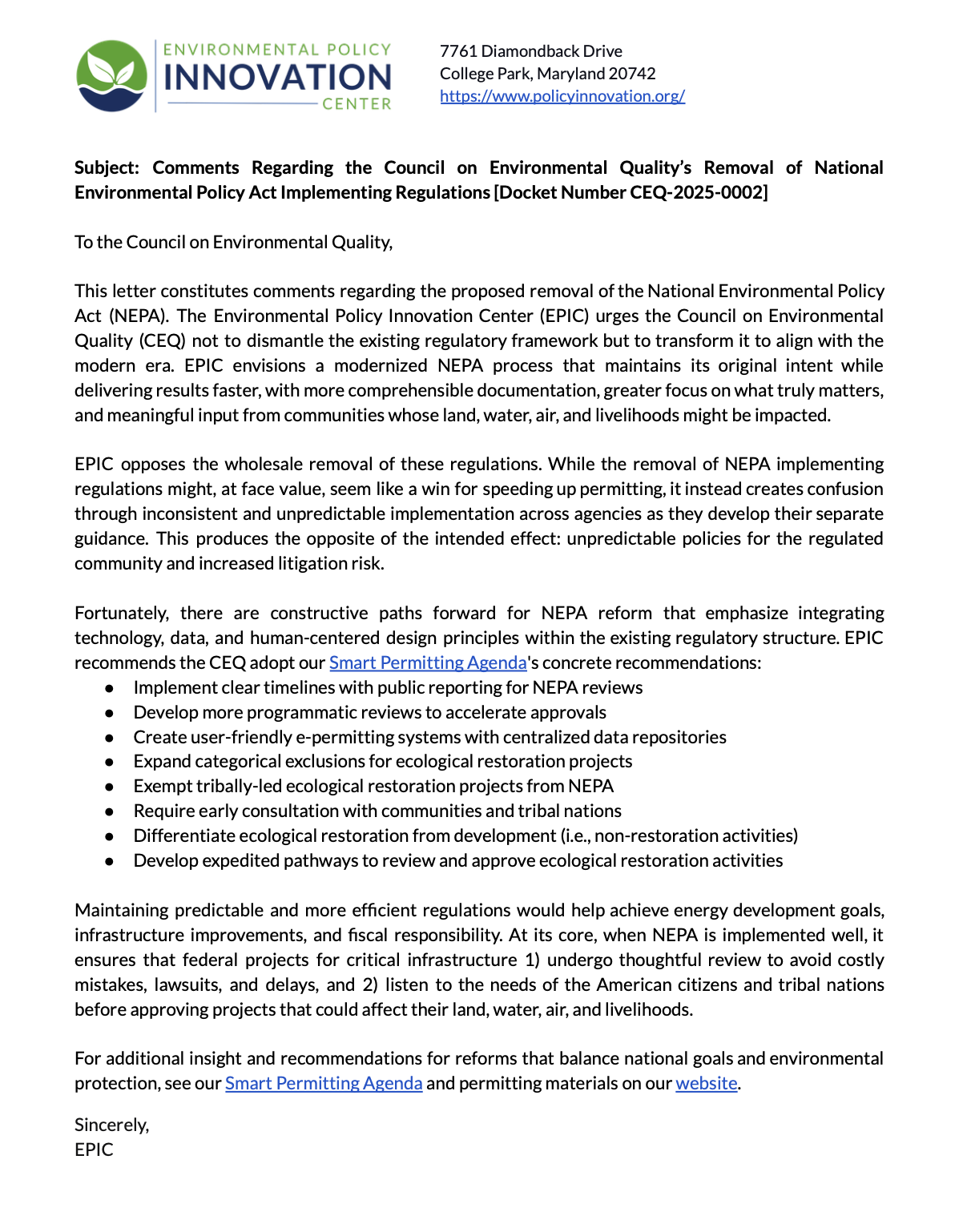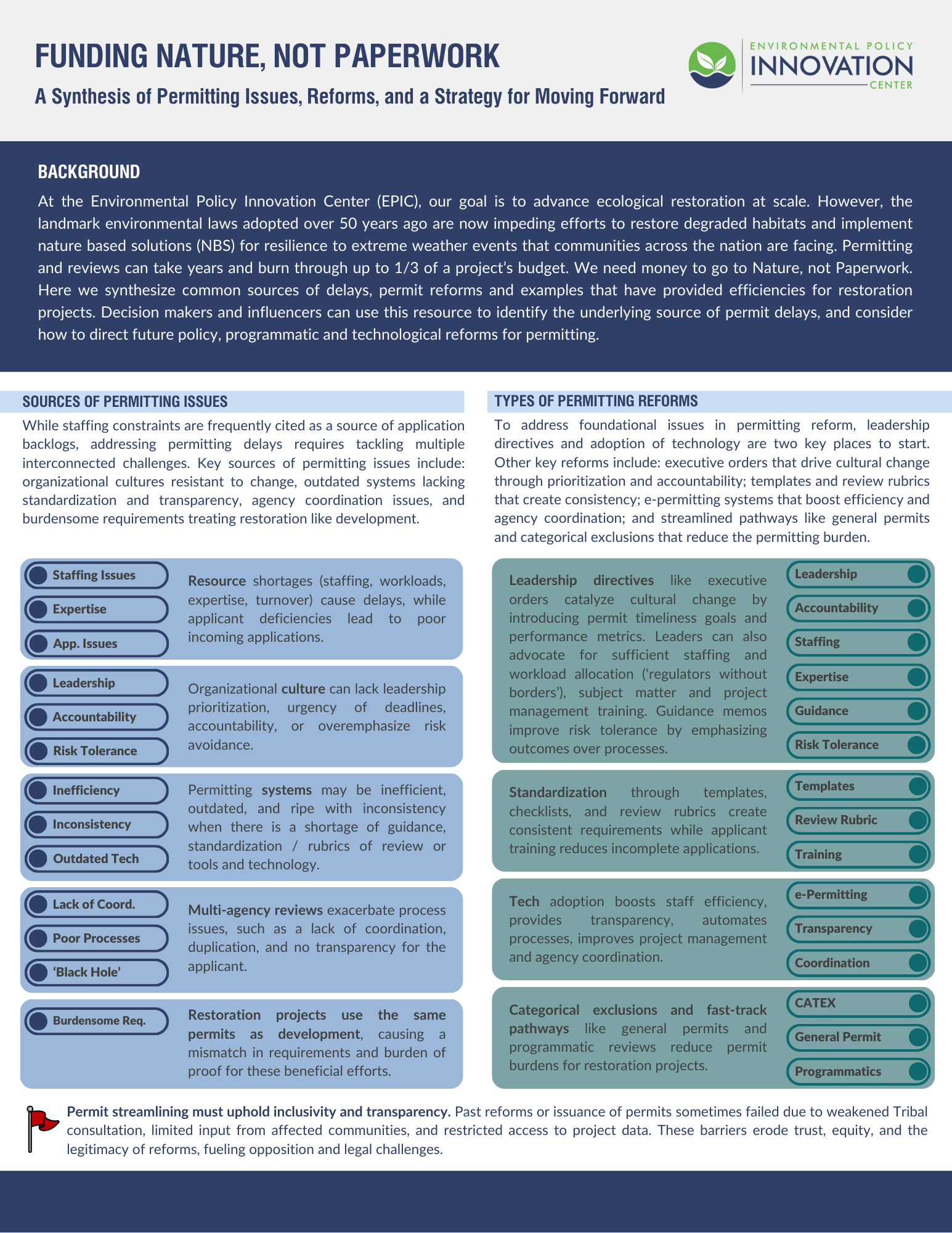Restoration Permitting
The Problem: Funding for Restoration is Going to Paperwork, not Nature.
Leaders around the globe committed to restoring 30% of the world’s degraded ecosystems (Target 2 of the UN Convention on Biological Diversity’s 2023 Kunming-Montreal Global Biodiversity Framework). But right now, the costs of permitting burn through up to ⅓ of a restoration project’s budget. We think restoration permits should take less than 1 year to approve.
The Solution: Streamline the Approval Process for Restoration Projects.
Through our work, we are identifying policy and programmatic changes to speed up the approval processes for restoration projects. Restoration projects are fundamentally different from impactful development projects, and regulators should create categorical exemptions, a fast-track path, interagency coordination opportunities, and transparent processes to speed the approval of these projects. Technology can also aid faster processes. EPIC now has a suite of resources to help decision makers and influencers understand pathways to speed permitting for restoration projects.
Jan 2025 2-page brief that synthesizes common sources of delays, permit reforms and examples that have provided efficiencies for restoration projects.
Dec 2024 1-page case study of Virginia’s Permitting Enhancement and Evaluation Platform (PEEP). Amongst the dozens of policy and tech efforts we’ve tracked, PEEP is a gold star example of the potential of technology to dramatically shorten permit backlogs, with a 70% improvement in processing times reported.
Jan 2024 4-page concept note on pathways to speed restoration permitting. The objective of the paper is to showcase eight pathways to speed permitting, along with excerpts from enabling policy text. These examples could be tailored and replicated in other contexts.
For other examples of restoration permit streamlining, check out our interactive database of policies and programs.
EPIC Restoration Permit Streamlining Work
-
EPIC created an interactive database of 49 legislation, policies, programs, and case studies that offer new pathways to buying environmental outcomes, and finding ways to reduce delays in permitting environmental restoration projects. The database is a helpful resource for policymakers and agency staff at the state and federal level. The information provides the raw ‘ingredients’ that could be used to replicate Pay for Success and Restoration Permit Streamlining in other contexts. Link to Database.
-
In a March 2023 report, EPIC, in collaboration with the Ecological Restoration Business Association (ERBA), revealed persistent delays in the approval of a class of wetland and stream restoration projects called ‘mitigation banks.’ These delays threaten to hinder the availability of offsets for impacted waterways during the coming surge in infrastructure building. Over the years, mitigation banking has fueled billions in investment towards conservation outcomes making it the largest U.S. environmental market for natural resource restoration. The researchers analyzed U.S. Army Corps of Engineers (Corps) data to see if timelines on mitigation banks were meeting the federally mandated approval time limit of 225 days, and found the average project took 1.5x longer than required “on the regulator’s desk.” The full timeline for project approval - including back and forth between the Corps and applicants - takes over 1,000 days on average (the longest project took over 12 years!).
Follow-on research in 2023 identified the top bottlenecks in the US Army Corps of Engineers’ review process and highlights dozens of solutions that could be implemented.
In 2024, EPIC analyzed new data new data on the timelines of mitigation bank review as well as the time it takes for credit release requests to get reviewed. It’s likely no surprise that we continue to find delays in the process - the part “on the regulator’s desk” takes 336 days (as opposed to the 225 days it’s supposed to take), and the total timeline has increased by over 50 days to an average of 1149-1195 days. The range reflects analyzing the data with and without some dubious data records.
With the caveat that the data do not indicate site visits, the range of credit release processing times was 1-1,829 days, with an average of 92 days.
2024
The Time it Takes for Restoration: 2024 Update
In September 2024, the US Army Corps of Engineers released two important directives publicly acknowledging delays, communicating that sticking to timelines is a priority, and identifying pathways to speed up the process while maintaining a focus on the same quality of ecological outcomes. Read more about the September 2024 Corps directives.
2023 reports
The Time it Takes for Restoration: An Analysis of Mitigation Banking Instrument Timelines (also see webinar recording)
The Time it Takes for Restoration: A Qualitative Analysis of Factors that Speed and Slow Mitigation Banking Approval Timelines (includes recommendations for streamlining the approval process, see p.22-29)
-
The regulatory process of establishing a conservation bank for state-listed species in California is hindered by inefficiencies and regulatory ‘green tape,’ resulting in delays beyond the state-mandated deadline of 270 days (SB 1148). EPIC launched a research effort to investigate what speeds and slows conservation bank approval timelines, and what ecological and economic consequences come from delayed processes. From an analysis of state agency ‘timestamp’ data of the approval process along with alternate data sources, EPIC identified that the total time to permit a conservation bank by the California Department of Fish and Game is between 761 - 1,740 days. Through a series of informational interviews, EPIC also identified bottlenecks and solutions to accelerate conservation bank approvals.
Conservation Banking in California: A Review of California Department of Fish and Wildlife Approval Timelines and Insights from Stakeholders (includes recommendations for streamlining the approval process, see p.23-26)
One question that arose from the research above was whether the slow process might contribute to a shortage of species credits, potentially delaying development and creating a species mitigation ‘debt’ — promised mitigation that remains unimplemented. To understand the scale of species mitigation under CESA being implemented versus unimplemented, EPIC initiated a second phase of investigation in 2024. The initial results, detailed below, are based on a Public Records Act request, which yielded substantial data from two California Department of Fish and Wildlife regions. From the data, we found that impacts are indeed outpacing mitigation, millions of dollars collected are not being used for species conservation, and there are concerning data gaps.
Promised but Pending - The Status of Mitigation Efforts for California's Endangered Species
-
EPIC has collected an inventory of environmental permitting tools, synthesized stakeholder input on a new US Army Corps of Engineers’ e-permitting system, conducted detailed user testing of the US Fish and Wildlife’s IPaC tool (for Section 7 ESA consultation), partnered on a user centered design process to envision a better RIBITS (tool used by wetland, stream, and species mitigation stakeholders), participated in an environmental technology & data summit (with some additional ideas synthesized here) and blogged on topics like data standards in environmental permitting, and permitting tech plays like using AI-enabled query resolution and AI document review.
See additional EPIC technology work here.
-
LinkedIn and Blog Posts:
Top 5 bipartisan permit reforms in NEPA regulations (about the Biden Administration’s final revisions to NEPA, May 2024)
One way to protect the wetlands the Supreme Court says don't matter (NEPA Sect 101 as a way to protect WL and streams, Nov 2023)
EPIC, FAS, and NEPAccess joint comments on NEPA Phase 2 Proposed Revisions (Sept 2023)
Top ten changes to NEPA in the debt limit deal(June 2 2023)
Top 20 ideas for conservation in Senate NEPA legislation (May 2023)
Top Ten Ideas for Better NEPA Outcomes (Feb 2023)
-































